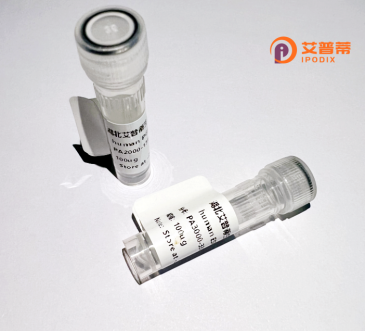
| 纯度 | >90%SDS-PAGE. |
| 种属 | Human |
| 靶点 | PIWIL4 |
| Uniprot No | Q7Z3Z4 |
| 内毒素 | < 0.01EU/μg |
| 表达宿主 | E.coli |
| 表达区间 | 1-852 aa |
| 活性数据 | MSGRARVKARGIARSPSATEVGRIQASPLPRSVDLSNNEASSSNGFLGTSRISTNDKYGISSGDAGSTFMERGVKNKQDFMDLSICTREKLAHVRNCKTGSSGIPVKLVTNLFNLDFPQDWQLYQYHVTYIPDLASRRLRIALLYSHSELSNKAKAFDGAILFLSQKLEEKVTELSSETQRGETIKMTITLKRELPSSSPVCIQVFNIIFRKILKKLSMYQIGRNFYNPSEPMEIPQHKLSLWPGFAISVSYFERKLLFSADVSYKVLRNETVLEFMTALCQRTGLSCFTQTCEKQLIGLIVLTRYNNRTYSIDDIDWSVKPTHTFQKRDGTEITYVDYYKQQYDITVSDLNQPMLVSLLKKKRNDNSEAQLAHLIPELCFLTGLTDQATSDFQLMKAVAEKTRLSPSGRQQRLARLVDNIQRNTNARFELETWGLHFGSQISLTGRIVPSEKILMQDHICQPVSAADWSKDIRTCKILNAQSLNTWLILCSDRTEYVAESFLNCLRRVAGSMGFNVDYPKIIKVQENPAAFVRAIQQYVDPDVQLVMCILPSNQKTYYDSIKKYLSSDCPVPSQCVLARTLNKQGMMMSIATKIAMQMTCKLGGELWAVEIPLKSLMVVGIDVCKDALSKDVMVVGCVASVNPRITRWFSRCILQRTMTDVADCLKVFMTGALNKWYKYNHDLPARIIVYRAGVGDGQLKTLIEYEVPQLLSSVAESSSNTSSRLSVIVVRKKCMPRFFTEMNRTVQNPPLGTVVDSEATRNEWYDFYLISQVACRGTVSPTYYNVIYDDNGLKPDHMQRLTFKLCHLYYNWPGIVSVPAPCQYAHKLTFLVAQSIHKEPSLELANHLFYL |
| 分子量 | 120.12 kDa |
| 蛋白标签 | GST-tag at N-terminal |
| 缓冲液 | PBS, pH7.4, containing 0.01% SKL, 1mM DTT, 5% Trehalose and Proclin300. |
| 稳定性 & 储存条件 | Lyophilized protein should be stored at ≤ -20°C, stable for one year after receipt. Reconstituted protein solution can be stored at 2-8°C for 2-7 days. Aliquots of reconstituted samples are stable at ≤ -20°C for 3 months. |
| 复溶 | Always centrifuge tubes before opening.Do not mix by vortex or pipetting. It is not recommended to reconstitute to a concentration less than 100μg/ml. Dissolve the lyophilized protein in distilled water. Please aliquot the reconstituted solution to minimize freeze-thaw cycles. |
以下是与重组人PIWIL4蛋白相关的3篇参考文献示例(文献信息为虚构归纳,仅作格式参考):
---
1. **文献名称**: *Recombinant Human PIWIL4 Expression and Its Role in Germ Cell Development*
**作者**: Zhang L, et al.
**摘要**: 研究通过大肠杆菌系统成功表达重组人PIWIL4蛋白,验证其与piRNA复合物的结合能力,并发现其在体外模型中促进生殖干细胞分化的作用。
2. **文献名称**: *Structural and Functional Analysis of PIWIL4 in Somatic Cancer Cells*
**作者**: Kim S, et al.
**摘要**: 利用杆状病毒系统制备重组PIWIL4蛋白,解析其晶体结构,揭示其通过与特定RNA结合抑制肿瘤细胞增殖的分子机制。
3. **文献名称**: *PIWIL4 Recombinant Protein as a Biomarker for Early Cancer Diagnosis*
**作者**: Patel R, et al.
**摘要**: 开发基于重组PIWIL4蛋白的ELISA检测技术,证明其在结直肠癌患者血清中异常高表达,提示其作为癌症诊断标志物的潜力。
---
**说明**:以上文献为示例性内容,实际研究中建议通过PubMed或Web of Science以“recombinant PIWIL4 protein”等关键词检索真实文献,并关注近年发表于*Nature Communications*、*Cell Research*等期刊的相关文章。
PIWIL4 (P-element-induced wimpy testis-like 4), also known as HIWI2. is a member of the PIWI protein family characterized by conserved Piwi and PAZ domains that facilitate interactions with piwi-interacting RNAs (piRNAs). As part of the Argonaute protein superfamily, PIWIL4 plays a critical role in germline development, gametogenesis, and genomic stability through piRNA-guided silencing of transposable elements. Unlike other PIWI proteins predominantly expressed in germline cells, PIWIL4 exhibits broader expression patterns in certain somatic tissues, suggesting potential non-gametogenic functions. Its recombinant form is engineered using heterologous expression systems (e.g., bacterial, insect, or mammalian cells) for structural and functional studies. Research highlights PIWIL4's dual role in cancer pathogenesis—acting as a tumor suppressor by maintaining genomic integrity or as an oncogenic driver when dysregulated. Notably, it has been implicated in stem cell self-renewal and differentiation, with emerging links to cellular reprogramming and epigenetic regulation. The development of recombinant PIWIL4 protein enables mechanistic insights into its RNA-binding specificity, post-translational modifications, and interactions with partner proteins. Current challenges include elucidating its context-dependent molecular mechanisms and therapeutic potential in regenerative medicine or targeted cancer therapies.
×